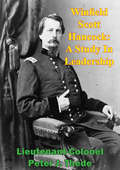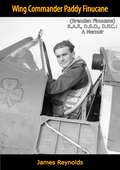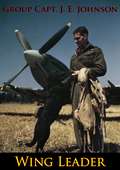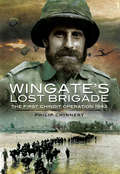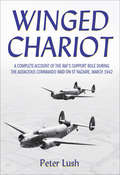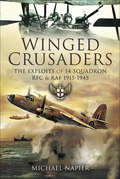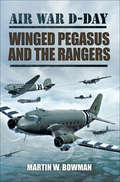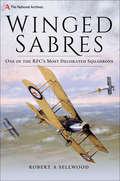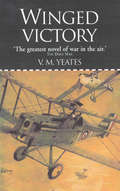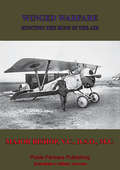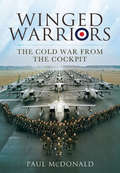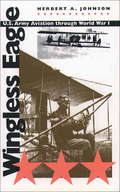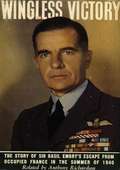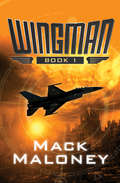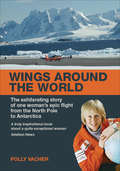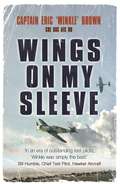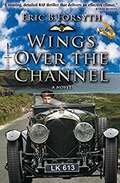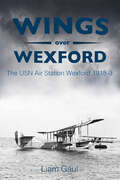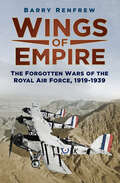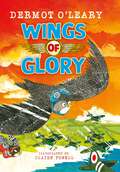- Table View
- List View
Winfield Scott Hancock: A Study In Leadership
by Lieutenant-Colonel Peter J. ThedeThe purpose of this study is to identify and analyze the leadership competencies of Major General Winfield Scott Hancock, the most consistently successful corps-level commander of the Civil War. Over the course of his 44 years in uniform, General Hancock participated in the Mexican War, Civil War, and Indian Wars. He was the candidate of the Democratic Party in the 1880 Presidential election. Nicknamed "Hancock the Superb", he was recognized as the best combat commander in the Army of the Potomac. Remaining a general in the Regular Army after the Civil War, Hancock played a major role in post-war affairs. In order to gain insight into Hancock's leadership competencies, DA Pamphlet 600-80 and Field Manual 22-103 will be used as a framework. Research will chronologically follow aspects of Hancock's life and career to identify skills as they are developed and employed.
Wing Commander Paddy Finucane (Brendan Finucane) R.A.F., D.S.O., D.F.C.: A Memoir
by James ReynoldsThis book was first published in 1942 as a tribute to Irish-born RAF fighter pilot and flying ace, Brendan Finucane (1920-1942), who died fighting for Britain during World War II.Known amongst his colleagues as “Paddy,” Finucane was credited with 28 aerial victories—five probably destroyed, six shared destroyed, one shared probable victory, and eight damaged—and was also noted for being the youngest person ever given command of a fighter wing in the history of aerial combat, namely the Hornchurch Wing.“IF SOMEONE asked me to describe Wing Commander Brendan Finucane R.A.F. in two words, I would say “bright and shining.” He seemed always to radiate light and lift of the spirit—his frequent smile, the way the corners of his generously drawn mouth went up—his witty friendly eyes—even his crisp dark red hair seemed always lifted by a breeze from “the upper air” he loved so well, the upper air in which from his eighteenth birthday until the day of July seventeenth, nineteen hundred and forty-two, he spent the greater part of his waking life. This smiling friendliness, this winning manner, caused him to be known as “Paddy” to all the world.”—JAMES REYNOLDS
Wing Leader
by Group Capt. Douglas Bader Group Capt. J. E. JohnsonThe thrilling story of the top scoring Allied fighter pilot of World War II 'Johnnie' Johnson, who served with Fighter Command squadrons throughout the war, scoring his 38th and final victory in September 1944. From the moment the author joins his first operational Spitfire squadron in August 1940, the reader is taken on an epic journey through the great aerial fighter actions of the war including the Battle of Britain, sweeps across the Channel and over France, Dieppe and Normandy; and finally, operations across the Rhine and into Germany itself."No one who wants to know what the air war was really like--anyway from the point of view of the fighter squadrons--can afford not to read this book by one of the most deservedly famous fighting officers in the short but glorious history of the R.A.F."The story, of course, is magnificent--the record of the brilliantly successful fighting career, from the Battle of Britain to victory in Germany, of the man who shot down more enemy fighters than any other R.A.F. officer. Group Commander Johnson writes nearly as well as he flies and fights--which is saying a good deal....A modest, straightforward, often superbly graphic account of nearly five years of fighting in the air."--Marshal of the Royal Air Force Sir John C. Slessor, FLIGHT Magazine"...will delight the professional airman and give the layman a view of combat air war that is rarely seen in a 'popular' account."--Air Force Magazine"Some of the best descriptions of combat in the air during World War II. The book is filled with many episodes that move as swiftly as Spitfires and Hurricanes...enough solid action to satisfy the most ardent adventure fan. At the same time he outlines air force training, planning and combat so skillfully that his well-written book is also a valuable treatise on the subject."--The New York Sunday Times Book Review"...absorbing and well-written personal account. A highly interesting narration of the human side of an airman's life throughout the war."--Herald Tribune Book Review
Wingate Pasha: The Life of General Sir Francis Reginald Wingate, 1861–1953
by R.J.M PughWingate Pasha is the first biography of an eminent Scottish soldier-statesman who contributed much to the development of the Sudan and Egypt during the late 19th and early 20th centuries. It tells the story of a man from an impoverished background with a rudimentary education who nonetheless mastered several foreign languages including Arabic. In 1884, Wingate joined the expeditionary force to relieve Khartoum, which arrived two days too late, General Gordon having been murdered. As Kitcheners Military Intelligence Officer, Wingate was instrumental in assisting Kitchener to recover Sudan from Dervish domination. As Governor-General of the Sudan, Wingates enlightened administration brought unprecedented political, social and economic prosperity to the Sudanese people. in the First World War, Wingate played a leading role in organising the Arab Revolt against the Turks, although it was his subordinate, T E Lawrence (of Arabia) who received the acclaim. After the war, as High Commissioner of Egypt, he continued to seek justice for the Egyptian people at the Paris Peace Conference which led to the signing of the Treaty of Versailles in 1919.He retired from public life to Dunbar in Scotland and had a successful business career until he died in 1953.
Wingate's Lost Brigade: The First Chindit Operations, 1943
by Philip D. ChinneryWith the Japanese seemingly unbeatable after their conquest of Malaya, Singapore, Thailand and much of Burma, Orde Wingates plans to conduct long range deep penetration operations behind Japanese lines in Burma were audacious to say the least. His Chindit operations (so called after Chindwin River) were hugely demanding on those taking part who suffered terrible deprivation in the harsh climatic and jungle conditions. While costly in terms of lives lost, the operations inflicted damage to the Japanese and raised Allied morale. The author has compiled a fascinating account of Wingates 77 Brigade using the personal accounts of survivors, as well as Wingates own report and post-war interrogation of Japanese generals. A remarkable story emerges of survival, courage and extreme hardship. The author evaluates the successes and failures of the mission.
Winged Chariot: A Complete Account of the RAF's Support Role During the Audacious Command Raid on St Nazaire, March 1942
by Peter LushAn impeccably researched examination of the role the RAF played during this epic World War II raid in German-occupied France. In what has been described as &“the greatest raid of them all,&” Operation Chariot saw heavy destruction of the enemy-occupied port of St. Nazaire by British forces. With focus on the planning and actions of the operation, Peter Lush explores the three functions carried out by the RAF: the sweeping of the Bay of Biscay, the diversionary raid, and protecting the withdrawing survivors. He also outlines the importance of the photographic Reconnaissance Unit to the raid and the development of the Bomber and Coastal Commands particularly though the sorties flown by Coastal Command two days before the attack started. The book also highlights the tragedy that occurred for the RAF, when diversionary raids were carried out in impossible conditions; resulting in the loss of aircraft across Yorkshire and in the Channel. Lush examines whether this could have been prevented if the RAF had not been marginalized during the planning process of Operation Chariot. This timely and ultimate account, written by an expert who has collated over forty years worth of research, is an essential work for all those interested in military aviation, particularly during the Second World War.&“Highly recommended for anyone interested in learning more about the history of World War II, and the unsung heroes.&” —IPMS/USA
Winged Crusaders: The Exploits of 14 Squadron RFC & RAF, 1915–45
by Michael NapierFormed in 1915, and still operational today, 14 Squadron is one of the RAF's longest serving and most senior Squadrons. Spending the first thirty years of its operational life in the Middle East, the history of this Squadron is a rich one, but one which, until now, has gone largely unrecorded. Napier effectively brings together all the historical scraps and shreds of stories which make up the collective history of this unit, from 1915 –1945, a period of great military and social upheaval. The author himself attests to the fact that the work is not merely about the aeroplanes operational history during this period, or the stark military facts (although enthusiasts of both these areas will find much here); rather, the work concerns itself to a large extent with the people who flew such aircraft. Recording the dramatic trials and tribulations of the people who were 14 Squadron, Napier provides a sympathetic and engaging account of this period of Military History.
Winged Pegasus and the Rangers: Winged Pegasus And The Rangers (Air War D-Day)
by Martin W. BowmanThis is the third volume of a comprehensive five part work, detailing every aspect of air and paratroop operations on the night of 5/6 June 1944. The 6th Airborne Division was to support British Second Army and First Canadian Army; its task was to seize and hold the left flank of the bridgehead. The 5th Parachute Brigade was to seize the ground each side of the bridges over the Canal du Caen and the Orne River, whilst on the same day seize and hold positions on the long wooded ridge beyond the waterways, running from Troarn in the south to the sea. This ridge with the bridges behind would eventually form the critical left flank of the army and the bridges had to be intact to permit Allied troops and supplies to pass easily back and forth. The 3rd Parachute Brigade, which included the 1st Canadian Parachute Battalion (1,800 men) was to prevent enemy reinforcements moving towards the British beachhead. Another Battalion and the 1st Canadian Brigade had to destroy five bridges in the flooded valley of the Dives. The 9th Battalion had to silence a battery of four concrete gun emplacements on high ground near the village of Merville, 3 miles east of Ouistreham. For these tasks 38 and 46 Groups RAF dispatched 264 aircraft and 98 glider combinations, the glider tugs being Albemarles, Dakotas, Halifaxes and Stirlings, the gliders mainly Horsas with a few Hamilcars (carrying light tanks and 17-pounder anti-tank guns). Meanwhile, Brigadier Lord Lovats 1st Special Service Brigade, composed of four Army and one Royal Marines Commando, reached Pegasus Bridge en route to help other units of the Airborne Division.Allied intelligence had pinpointed 73 fixed coastal gun batteries that could menace the invasion. At Pointe-du-Hoc, a cliff rising 100 feet high from a very rocky beach, a six-gun battery which potentially could engage ships at sea and fire directly onto Utah and Omaha was taken by three companies (225 men) of the US 2nd Ranger Battalion using rocket propelled grapple hooks attached to climbing ropes and portable extension ladders to scale the cliffs within ten minutes after landing and capture the position.This dynamic episode in the history of D-Day is expertly researched and relayed with both style and reverence for the aircrew who participated in proceedings. A plate section of rare black and white images supplement the text, working further to create a real sense of the times at hand at this most pivotal point in the history of D-Day.
Winged Sabres: One of the RFC's Most Decorated Squadrons (The\national Archives Ser.)
by Robert A. SellwoodWinged Sabres is the story of a RFC & RAF squadron flying the cumbersome FE2 from February 1916 to September 1917, and then the superlative Bristol Fighter: a two-seater fighter-reconnaissance squadron with an astonishingly high success rate.20 Squadron was possibly the highest scoring squadron of the war and one of the most highly decorated, claiming over 600 combat victories with well over 400 confirmed in RFC & RAF Communiqus. Its members won seventy gallantry decorations including a posthumous Victoria Cross, and included fliers from the U.K. and around the world. Over 40 became aces, including the American Iaccaci brothers and some Canadians and others. But with a casualty rate of around 50% including killed, wounded and POW they paid a high price.Over 15 years research has gone into this book, covering a seldom-explored aspect of WW1 in the air: the two-seater fighter-reconnaissance squadrons. 20 Squadrons motto was Facta Non Verba Deeds Not Words!
Winged Victory (Echoes Of War Military History Ser.)
by V.M. YeatesExperience the chilling combat of World War I from inside an early biplane in this classic novel, by a pilot who lived through the war himself. France, 1914. The war on the land is taking to the skies . . . Pilot Tom Cundall is ready to take on the enemy in his trusty Camel fighter plane. But as he sees more and more planes shot down in flames, he begins to question the war, and what, or who, he is fighting for. There is no bitter snarl nor self-pity in this classic novel about the air war of 1914-1918, based very largely on the author&’s experiences. Combat, loneliness, fatigue, fear, comradeship, women, excitement—they all are part of a brilliantly told story of war and courage by one of the most valiant pilots of the then Royal Flying Corps.Praise for Winged Victory&“The greatest novel of war in the air.&” —The Daily Mail (UK)&‘Beautifully written with a poet&’s eye as well as a pilot&’s eye.&” —Evening Echo (UK)&“Not only one of the best war books . . . but as a transcription of reality, faithful and sustained in its author&’s purpose of re-creating the past life he knew, it is unique.&” —Henry Williamson, author of Tarka the Otter
Winged Victory [Illustrated Edition]
by V. M. YeatesIncludes Aerial Warfare During World War I Illustrations Pack with 115 maps, plans, and photos."There is no bitter snarl nor self-pity in this classic novel about the air war of 1914-1918, based very largely on the author's experiences. Combat, loneliness, fatigue, fear, comradeship, women, excitement -- all are built into a vigorous and authentic structure by one of the most valiant pilots of the then Royal Flying Corps.REVIEWS'The greatest novel of war in the air.'--Daily Mail'Beautifully written with a poet's eye as well as a pilot's eye.'-- Southern Evening Echo'The only book about flying that isn't flannel.'--Anonymous Fighter Pilot'Not only one of the best war books...but as a transcription of reality, faithful and sustained in its author's purpose of re-creating the past life he knew, it is unique.'--Henry Williamson, author of Tarka the Otter."-Print ed.
Winged Warfare - Hunting The Huns In The Air [Illustrated Edition]
by Major Billy Bishop V.C. D.S.O. M.C.[Illustrated with 17 additional photos of the author and the machines he flew and fought against]As a young Billy Bishop looking up into the sky above his Canadian trench in July 1915, a passing Royal Flying Corps aircraft was returning home from patrol. He was envious and said to whoever was listening "...it's clean up there! I'll bet you don't get any mud or horse **** on you up there. If you die, at least it would be a clean death.". Struck by his sudden epiphany he requested a transfer to the Royal Flying Corps, it was a momentous decision, for within the next three years Bishop would claim 72 victories over his German opponents, making him the highest scoring British Empire air ace of the First World War.A National Hero in his native Canada, he was awarded a V.C. for conspicuous services - the citation read:"For most conspicuous bravery, determination, and skill. Captain Bishop,...[On his own] flew first of all to an enemy aerodrome; finding no machines about, he flew on to another aerodrome...which was at least 12 miles the other side of the line. Seven machines....were on the ground. He attacked these from about fifty feet...One of the machines got off the ground, but at a height of 60 feet, Captain Bishop fired 15 rounds into it at very close range, and it crashed to the ground. A second machine got off the ground, into which he fired 30 rounds at 150 yards range, and it fell into a tree. Two more machines then rose from the aerodrome. One of these he engaged at a height of 1,000 feet, emptying the rest of his drum of ammunition. This machine crashed 300 yards from the aerodrome, after which Captain Bishop emptied a whole drum into the fourth hostile machine, and then flew back to his station. Four hostile scouts were about 1,250 feet above him for about a mile of his return journey, but they would not attack. His machine was very badly shot about by machine gun fire from the ground."A fine memoir from an Air Ace legend.
Winged Warriors: The Cold War from the Cockpit
by Thomas McDonaldPaul McDonald is a former RAF fast-jet pilot whose flying career spanned 34 years. He is not a typical senior RAF officer having been brought up on a council estate in a bleak northern industrial town. He became a pilot by accident and struggled to gain his wings. He spent 14 years on operational tours overseas including 2 tours at the height of the Cold War on a Tornado tactical nuclear squadron in Germany, only 15 minutes from responding to an anticipated Soviet onslaught. Earlier he served on a low-level photo reconnaissance squadron on NATO's vulnerable southern flank. He was decorated for gallantry in 1980 and later served in Kuwait as the Senior RAF Adviser, including Operation Desert Fox, the air war against Iraq in 1998.
Wingless Eagle
by Herbert A. JohnsonAt the start of the twentieth century the United States led the world in advances in aviation, with the first successful engine-powered flights at Kitty Hawk, North Carolina, and Dayton, Ohio, beginning in 1903. Fifteen years later, however, American airmen flew European-designed aircraft because American planes were woefully inadequate for service on the Western Front. Why was the United States so poorly prepared to engage in aerial combat in World War I? To answer this question, Herbert Johnson takes a hard look at the early years of U.S. military aviation, exploring the cultural, technical, political, and organizational factors that stunted its evolution. Among the recurring themes of Johnson's narrative are the damaging effects of a chronic lack of governmental funding for military aeronautics and the disruptive influence of a civilian "aeronaut constituency" both on military discipline and on public and Congressional attitudes toward army aviation. In addition, the Wright brothers' patent litigation hindered the technical development of American aircraft and crippled the domestic aviation industry's manufacturing capacity. Wartime experience helped correct some of these problems, but the persistence of others left the postwar Air Service with an uncertain and stormy future.
Wingless Victory: The Story of Sir Basil Embry’s Escape from Occupied France in the Summer of 1940
by Anthony RichardsonWINGLESS VICTORY is the story of an audacious and desperate man on the run, the record of one of the first wartime escapes through Occupied France. It reads like a first-class thriller and, as one critic puts it, "leaves fiction gasping far behind." On May 27, 1940, Wing-Commander Basil Embry (later Air Chief Marshal Sir Basil Embry, and Commander, Allied Air Forces in Central Europe 1953-56), although appointed to a higher command, decided to lead his old squadron into battle for the last time. Within the hour he was shot down in France and found himself alone, unarmed, and in uniform. Capture was inevitable. He was, in fact, captured three times, but refused to submit. Once he broke from a column of prisoners under the muzzle of a German machine-gun. Another time he fought his way out, killing three Germans with a stolen rifle and then hiding in a manure heap for nearly six hours. But perhaps the most amazing of all his exploits was the occasion on which, in the role of a fanatical member of the Irish Republican Army, he shook his fist under the nose of a German inquisitor, yelling hatred and abuse of Britain until his captors finally turned him loose to find his own way home. At this period there was little of escape technique to guide him and he had no opportunity to lay plans or prepare equipment. Yet, by sheer courage and wit, he found his way back to Britain to fight and fly again. He won the D.S.O. and three bars, and the D.F.C."The author succeeds in communicating vividly, yet unpretentiously, the sensations of a man on the run....About ten times as exciting as a fictional thriller."--Sunday Times"A thrilling and authentic escape story--will prove a classic."--Daily Herald"The records of World War II have no wilder or stranger story to tell."--Tatler"It is an extremely exciting story, but well spiced with humour as well."--Illustrated London News
Wingman (Elite Ops #2)
by Emmy CurtisSizzling hot and full of action, the Elite Ops military romance series is perfect for fans of Suzanne Brockmann, Julie Ann Walker, and Lynne Ray Harris.The higher the risk, the harder the fall.Maj. Missy Malden loves her job, her plane, and its pilot-not that she could ever let him know. He's way too cocky, way too sexy, and in their job, any distraction is way too dangerous. But when a training exercise spirals out of control, Missy's in the hot seat, and Conrad's the only one who can bail her out . . . Lt. Col. Francis Conrad has always valued Missy too much as his weapons specialist to ever tell her how he really feels. But now that she's been accused of treason, he can't sit back and let her fly solo. To keep her safe, he'll put everything on the line-his career, his heart, and even his life.
Wingman: The Tomorrow War (Wingman #1)
by Mack MaloneyThe first book in the bestselling, action-packed Wingman Series: With America in ashes, and lawlessness threatening to rule land, air, and sea, one pilot stands poised to pull his nation back from the brink of all-out anarchy The Big War started in Western Europe with a Soviet nerve gas attack that laid waste to France, Germany, and Spain. The world&’s democracies fought back, and pilots like Hawk Hunter led the charge—tearing across the flaming wreckage of the continent at supersonic speeds. They pushed the Russians back and just when victory was in sight, a traitor at the highest level of government turned off America&’s missile defense system, and Soviet nukes rained from the sky. Two years after the nuclear holocaust, Hunter gets a message to report to his old commander. America is in pieces: Pirates rule the skies, and an airborne armada is plotting to attack Football City (formerly known as St. Louis). The armada is made up of criminals flying state-of-the-art jets, and even though the government can only offer Hunter his old F-16, he will do whatever it takes to reclaim his ravaged homeland. Wingman is the first book of the Wingman series, which also includes The Circle War and The Lucifer Crusade.
Wings Around the World: The Exhilarating Story of One Woman's Epic Flight From the North Pole to Antarctica
by Polly VacherOn May 6, 2003, Polly Vacher took off from Birmingham airport seeking to become the first pilot to complete a solo flight around the world via both Poles in a single-engine aircraft. Despite having only a few years of flying experience, Polly, a 59-year-old mother of three, had already completed a lateral solo circumnavigation of the world in 2001 for the charity Flying Scholarships for the Disabled; this second challenge, for the same charity, would make that achievement look like a casual jaunt. There would be no margin for error. Her voyage to the ice was a 35,000-mile adventure in her Piper Dakota that would take her to at least 30 different countries on every single continent. She had prepared meticulously for two years, was fully insured and had all the requisite permits and visas. With her kinetic enthusiasm, charm and persistence, she had already garnered multifarious sponsors ranging from multinationals such as Shell to private individuals. However, as she took off on that blustery spring day, flanked by a Hurricane and a Spitfire from the RAF Battle of Britain Flight, and waved off by her family and the Prince of Wales, she suddenly felt so alone. She had begun a remarkable expedition that would gain her three world records, but would also see her encounter extremes of weather and emotion, much kindness and obstruction and also a little political intrigue.
Wings Of Morning: The Story Of The Last American Bomber Shot Down Over Germany In World War II
by Thomas ChildersOn April 21, 1945, the twelve-member crew of the Black Cat set off on one of the last air missions in the European theater of World War II. Ten never came back. This is the story of that crew—where they came from, how they trained, what it was like to fly a B-24 through enemy flak, and who was waiting for them to come home. <P><P>Historian Thomas Childers, nephew of the Black Cat's radio operator, has reconstructed the lives and tragic deaths of these men through their letters home and through in-depth interviews, both with their families and with German villagers who lived near the crash site. In so doing he unearths confusion about the exact number of crash survivors and ugly rumors of their fate at the hands of the German villagers. His search to determine what really happened leads him to the crash site outside of Regensburg to lay the mystery to rest.In the tradition of Young Men and Fire, Wings of Morning is history as commemoration-an evocation of people and events that brings to life a story of love, loss, and a family's quest for truth.
Wings On My Sleeve: The World's Greatest Test Pilot tells his story
by Eric BrownThe autobiography of one of the greatest pilots in history.In 1939 Eric Brown was on a University of Edinburgh exchange course in Germany, and the first he knew of the war was when the Gestapo came to arrest him. They released him, not realising he was a pilot in the RAF volunteer reserve: and the rest is history. Eric Brown joined the Fleet Air Arm and went on to be the greatest test pilot in history, flying more different aircraft types than anyone else. During his lifetime he made a record-breaking 2,407 aircraft carrier landings and survived eleven plane crashes. One of Britain's few German-speaking airmen, he went to Germany in 1945 to test the Nazi jets, interviewing (among others) Hermann Goering and Hanna Reitsch. He flew the suicidally dangerous Me 163 rocket plane, and tested the first British jets. WINGS ON MY SLEEVE is 'Winkle' Brown's incredible story.
Wings Over The Channel
by Eric ForsythWings Over the Channel follows the continuing adventures of Allan Chadwick, a young RAF pilot who completed his tour in Iraq and is now posted to the RAF aviation research center at Farnborough in southern England. It is the mid-1930s and Britain is threatened by belligerent countries such as Nazi Germany and Fascist Italy. The rapid development of high-speed bombers negates the centuries-old isolation that Britain enjoyed as an island. <P><P> Chadwick is involved in the RAF’s frantic effort to build an effective radar screen, and uses an early model Spitfire for liaison with outlying radar stations, flying in fair weather or foul, as he contends with the idiosyncrasies of the prototype fighter. Closer to earth he drives an old, monstrous Bentley, which attracts attention wherever he goes. He falls in love with an older, aristocratic widow who supports a secretive upper-class appeasement clique which, unbeknownst to them, has been compromised by the German Abwehr <P><P> British Intelligence decides it is impossible to keep the existence of radar a secret from the German Luftwaffe, but its effectiveness is downplayed in misleading reports fed to the Germans by Chadwick. The success of the deception—and Chadwick’s life— are threatened when an accurate report of radar performance is stolen by a German spy.
Wings Over Wexford: The USN Air Station Wexford 1918-19
by Liam GaulIn 1918, during the final year of the First World War, the USN had a force of over 400 sailors and 22 officers and 4 Curtiss H16 seaplanes based in at Ferrybank, Wexford. The base was a veritable village with accommodation, hospital, medics, post office, YMCA Hall, radio towers, electricity generating plant and very large aircraft hangers. Although only operational for a limited period, its impact on the town of Wexford was considerable and its achievements in the global conflict were significant, protecting shipping, both naval and commercial, from the German u-boats. To mark the impending 100-year anniversary of this base, this book by local historian Liam Gaul recalls this often-overlooked aspect of Ireland’s involvement in the First World War.
Wings of Empire: The Forgotten Wars of the Royal Air Force, 1919-1939
by Barry RenfrewAt the end of the First World War, British power in the colonies was at an all-time low. That was until a ragtag band of visionaries, including Winston Churchill and T.E. Lawrence, proposed that the aeroplane, the wonder weapon of the age, could save the empire. Using the radical strategy of air control, the RAF tried to subdue vast swathes of the Middle East, Asia and Africa. Wings of Empire is a compelling account of the colonial air campaigns that saw a generation of young airmen take to the skies to battle against warlords, jihadists and hostile tribes. For the first time ever, this book chronicles the full story of the RAF’s most extraordinary conflict.
Wings of Glory: An amazing wartime action-adventure story for readers aged 8+ from the author of Toto the Ninja Cat (Wartime Tails)
by Dermot O’LearyCan one tiny bird help to win a world war? Wings of Glory is a funny action-adventure story with a feathery twist, from the bestselling children's author of Toto the Ninja Cat, Dermot O'Leary, with glorious illustrations throughout by Claire Powell.It's 1940, and the world is at war. Linus, a swift, has always dreamed of flying with the Royal Bird Force and making a name for himself as a squadron leader. So when he and his sister, Ava, have the opportunity to volunteer, he jumps at the chance.But it's a dangerous journey, and Ava goes missing before they manage to reach the airfield for training. Now, Linus has two missions: help the war effort and find his sister.Linus will face bomber planes, arrogant falcons, and a spy who's determined to take him down...He is brave and fast and kind - but can Linus prove that helping win the war is more about the size of your heart than the size of your wings?Featuring courageous loop-the-loops, top secret plans and more than a smattering of bird poo, this wartime tail will make you laugh and cry - and maybe teach you a thing or two as well.
